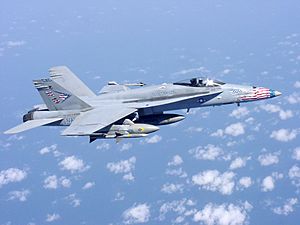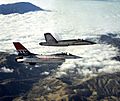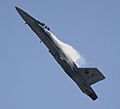McDonnell Douglas F/A-18 Hornet facts for kids
The F/A-18 Hornet is a fast fighter jet that can do many jobs. It was first made by McDonnell-Douglas and is now built by Boeing. This amazing aircraft first flew in 1978 and started being used in 1983. The main user of the F/A-18 Hornet is the United States Navy.
One special thing about the F/A-18 is that it can take off and land on aircraft carriers. This is because of its unique design. The F/A-18 can attack targets both in the air and on the ground. An aircraft that can do both of these jobs is called "multi-role." The Hornet is also flown by the famous Blue Angels aerobatic team.
Contents
Who Uses the F/A-18 Hornet?
The F/A-18 Hornet is used by several countries around the world, including the United States Navy.
United States
The United States Marine Corps currently uses 143 F/A-18 aircraft. They plan to keep using these Hornets until the early 2030s.
The U.S. Navy used the F/A-18C Hornet for a long time. Its last big mission at sea was on the USS Carl Vinson aircraft carrier, ending in March 2018. The Navy officially stopped using the F/A-18C for active duty in February 2019. However, some reserve units still use them, mainly for training against other aircraft.
Blue Angels
The Blue Angels are a famous flight demonstration team from the U.S. Marine Corps. They fly the F/A-18 Hornet in amazing airshows. Before they used the Hornet, they flew the A-4 Skyhawk.
Australia
The Royal Australian Air Force (RAAF) bought 57 F/A-18A and 18 F/A-18B Hornets in 1981. The F/A-18B model was used for training pilots. These Hornets replaced their older Mirage III jets. The Australian Hornets are a bit different from the U.S. versions. The RAAF removed the parts that allow the plane to land on aircraft carriers. This is because Australia does not have aircraft carriers big enough for these planes.
What Weapons Can the Hornet Carry?
The F/A-18 Hornet can carry many different types of weapons. These include bombs, missiles, rockets, and a powerful gun. It can also carry special "pods" that give the aircraft more abilities. For example, a Litening targeting pod helps the pilot see targets on the ground and guide bombs to hit them accurately.
Bombs
The Hornet can carry various bombs for different missions:
- Joint Direct Attack Munition (JDAM)
- Paveway laser guided bombs (these bombs are guided by the targeting pod)
- Mk80 bombs (general purpose bombs)
- CBU100 cluster bomb
- B81 and B83 nuclear bombs
Rockets
For shorter-range attacks, the Hornet can use rockets:
- 2.75 inch (70 mm) Hydra 70 rockets
- 5 inch (127.0 mm) Zuni rockets
Missiles
The F/A-18 Hornet carries many types of missiles for both air-to-air and air-to-ground combat.
Air-to-Air Missiles
These missiles are used to shoot down other aircraft:
- Aim-120 AMRAAM
- Aim-9 Sidewinder
- Aim-132 ASRAAM
- Iris-T
- Aim-7 Sparrow
Air-to-Ground Missiles
These missiles are used to attack targets on the ground or at sea:
- AGM-65 Maverick
- AGM-88 HARM
- AGM-164 Joint Standoff Weapon (JSOW)
- Taurus Cruise Missile
Anti-Ship Missiles
- AGM-84 Harpoon (used to attack ships)
Related pages
Images for kids
-
F/A-18C Hornet in transonic flight producing flow-induced vapor cone
-
Exhaust nozzles of an RAAF F/A-18
-
NF101, an F/A-18A Hornet assigned to VFA-195 Dambusters aboard the USS Midway, CV-41 in the 1991 Gulf War.
-
Canadian CF-188A Hornet off Hawaii. Note the "false cockpit" on the underside of the aircraft for confusing enemy pilots during dogfights.
-
An US Marine Corps F/A-18C of VMFA-323, launches off the flight deck of the USS Nimitz.
-
X-53, NASA's modified F/A-18
-
F/A-18A on display at the Air Zoo
-
VX-4 F/A-18 with ten AIM-120 AMRAAMs and two AIM-9 Sidewinders
-
M61 Vulcan on display at Miramar Airshow
See also
 In Spanish: McDonnell Douglas F/A-18 Hornet para niños
In Spanish: McDonnell Douglas F/A-18 Hornet para niños



































